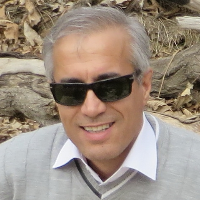The Study of Geometric Motifs of Plaster Altar of Ilkhanid Period in Iran
The plaster altars of Ilkhanid period, as one of the most glorious decorative representations of architecture of this period, are a unique collection of motifs and different inscriptions that has a great diversity in construction dimensions and forms. These reliefs that are included in almost all parts of plaster altars, including frontal, margins, columns, capitals, arches, etc. have different plant (arabesque and khataei) and geometric reliefs most of them are integrated with existing Kufic scripts. In this article, the researcher tries to introduce different geometric motifs used in plaster altars of Ilkhanid period and evaluate the variety, constancy or frequency and application of each of these nodes in different parts of altars, in terms of the extent of assigned area and the used position.
In this research that is done with a focus on the stuccoed altars attributed to the Ilkhanid period 12 stuccoed altars are selected from 5 provinces and the researcher tries to answer the following questions: what are the mostly used nodes in the stuccoed altars of the Ilkhanid period? Where are these nodes used in different parts of the altar and what is their relation with the plant designs or lines used in the altars? Regarding the fact that needle decorations are identified as the common geometric designs in the plaster works of Seljuq and Ilkhanid periods, the researcher does not consider them in this research and just focuses on the node designs. Since it is very important to deal with the plaster arrays that have geometric motifs and there is not any rule to detect and distinguish the altars of Ilkhanid period from the samples that were made before, this research can be considered as an introduction for understanding the visual styles of the ornaments during the Ilkhanid period which have been ignored in the literature so far.
Data collection has been made based on field research (taking photos, linear analysis of pictures) and written references that has analyzed the collected data from the samples through historical- comparative method based on geometric patterns. First, each altar and its motifs (especially the geometric ones) are described and then, they are classified and analyzed using the tables, diagrams and investigating some samples of the geometric motifs and the places they were used and also integrating them with other motifs and scrolls. The data was collected using documentary resources, field researches, observations made by the authors, images of the geometric motifs of the altars and drawing different types of nodes with Matrix 7.0.
The results obtained from 12 dated plaster altars of Ilkhanid period shows that the role of these Knots in these altars is very important most of them are based on the numbers 6 and 8. These Knots are mostly on the side walls, in front of arch and the edges of the plaster altars and in the most studied samples, the Knots are integrated with plant motifs (flowers, leaves, etc.) and simple geometric figures (circle, triangle, oval, etc.). Among the studied stuccoed altars, the only one in which nodes have been used widely, is the arcade of the altar in the central Mosque of Orumieh (Urmia) because this kind of node has not been used in any of the other plastered altars of Ilkhanid period. Oljeitu altar is the only example in which there is the unique node of reversed top that has been combined with Kufic inscriptions.
Generally, it is possible to classify the nodes in the stuccoed altars of Ilkhanid period in terms of patterns and designs into the following groups: the function of simple nodes alone in the narrow borders; the integration of simple and complex nodes with the plant designs (flower and leaf); using node on background of plants designs such a way that these two forms of design are not related meaningfully; the integration of node with the Kufic inscriptions. The spaces in the altars that are assigned to the nodes are the inner surface of arcades, front or side wall of the arcades, spandrels and half columns and because these sections are so important in the altars, the function of nodes in the stuccoed altars cannot be ignored or considered as subsidiary. But what is important here is that almost in all the samples that were studied (except some nodes that were used in the narrow borders and columns), the nodes have been integrated with the plant elements (arabesques and khataei) or exist beside them simultaneously and this is one of the significant features of geometric motifs in the stuccoed altars of Ilkhanid period.
- حق عضویت دریافتی صرف حمایت از نشریات عضو و نگهداری، تکمیل و توسعه مگیران میشود.
- پرداخت حق اشتراک و دانلود مقالات اجازه بازنشر آن در سایر رسانههای چاپی و دیجیتال را به کاربر نمیدهد.


